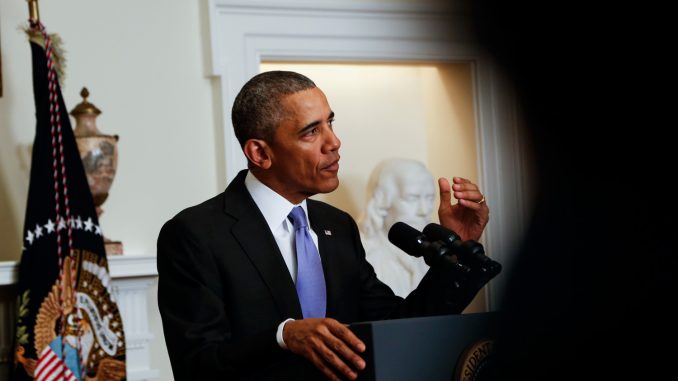America paid Iran $1.7 billion in cash—funds that by law were not to be released unless and until Iran paid what it owed to American victims of its terrorism.

On the morning of January 17, 2016, President Obama declared that this was “a good day, because, once again, we’re seeing what’s possible with strong American diplomacy.”
The Iran nuclear deal had been implemented the day before—an example, the President said, of his “smart, patient, and disciplined approach to the world.” Now Iran was releasing five American hostages, the result of the administration’s “tireless” efforts. “On the sidelines of the nuclear negotiations,” the president explained, “our diplomats at the highest level, including Secretary [of State John] Kerry, used every meeting to push Iran to release our Americans.” In return for that gesture, the president continued, he was making a “reciprocal humanitarian gesture”: namely, clemency for seven Iranians imprisoned or awaiting trial for criminal violations of American sanctions. Later it was announced that the U.S. had also dropped outstanding warrants against another fourteen Iranians.
The president then added something else: with the nuclear deal implemented, and the hostages released, “the time was right” for “resolving a financial dispute that dated back more than three decades.” That dispute involved an Iranian claim regarding money advanced by the government of the Shah for military equipment that Washington did not deliver after the 1979 revolution. Now, the president asserted, we were returning Iran’s “own funds,” including “appropriate interest,” but “much less than the amount Iran sought.” The savings, he said, came potentially to “billions”—a figure quantified by his press secretary as “up to $6 billion or $7 billion” in a “very good deal for taxpayers.” In other words, now that the larger issues had been resolved, the U.S. was simply issuing a long-delayed refund to Iran, and in the process saving Americans a significant amount of money.
The president’s statement, however, omitted a great deal of relevant information. The president was returning $400 million in Iran’s “Foreign Military Sales” (FMS) account with the Pentagon, plus $1.3 billion in interest, but he failed to mention that in 1981, when Iran filed its claim before the Claims Tribunal at The Hague, the U.S. had responded with a counterclaim for $817 million for Iran’s violations of its obligations under the FMS program. In 2016, with both the claim and the counterclaim still pending, it was possible that Iran owed billions of dollars to the U.S., not the reverse.
Nor did the president mention the Victims of Trafficking and Violence Protection Act, signed by President Bill Clinton in 2000 and stipulating that Iran’s FMS account could not be refunded until court judgments held by the U.S. government against Iran for damages from terrorist acts against American citizens were resolved to America’s satisfaction. Those judgments, including interest accumulated between 2001 and 2016, totaled about $1 billion. The president did not explain how, under the 2000 law, with those judgments still outstanding, he could pay Iran anything at all.
Nor did the president mention that his “refund” to Iran was being paid in untraceable European cash, a fact discovered by reporters seven months later. He would then contend that, in light of the sanctions on banking transactions with Iran, “we had to give them cash.” But the sanction regulations expressly authorize bank payments to settle Iran’s claims at The Hague, as Michael Mukasey, the former U.S. attorney general, later testified to Congress, adding that there was “no legitimate reason why [Iran] should want cash other than to pursue terrorism.” Indeed, the Hizballah International Financing Prevention Act, passed by Congress in December 2015, had resulted in Tehran’s needing significantly more cash to continue funding its terrorist organization in Lebanon, Syria, and elsewhere.
In a February 3 letter, Ed Royce, the chairman of the House Foreign Affairs Committee, asked the administration to provide the legal basis for paying Iran’s claim, as well as a specific computation of the interest paid. He repeated the request in a June 1 letter, adding that according to information provided to him by the Congressional Research Service, the Hague tribunal paid 10-percent simple interest on such claims. Computed at that rate, and before considering the U.S. counterclaim under the FMS and the terror judgments still outstanding, Iran’s total claim on the FMS account was virtually identical to the $1.7 billion the administration paid, with no “billions” in savings.
To date, the administration has released no legal analysis to support its payment, no evaluation of the U.S. counterclaim, no text of the settlement agreement, no computation of the interest, no credible explanation for issuing the payment in cash, and no document showing the approval of the attorney general as required for issuing such a payment. For months, the administration hid important facts—including how the settlement was paid—even in response to direct congressional inquiries.
The $1.7-billion payment thus appears to have been a ransom, just as an Iranian general claimed it was at the time—a huge cash payment to accompany the lopsided exchange of 21 Iranians, duly charged or convicted under American law, for five American hostages who had been seized by Iran and held on fabricated charges in secret proceedings.



Deep down the Obamas hate America.